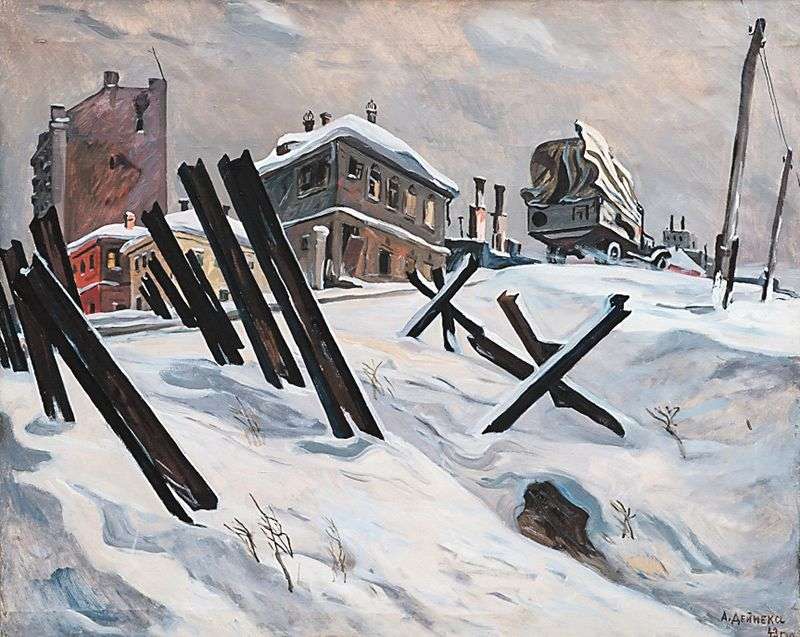
How often also in our time, some artists, referring to military themes, “by tradition” depict a semi-fantastic kind of battle, a clash of troops, in a word, battles! The pictures of such authors, at first glance striking a beating in the eye of an abundance of effects, do not always deeply reveal the theme they have taken. At the same time there are works telling about the war, in which there is nothing external, catchy, but nevertheless possessing great force of figurative influence.
This is the picture of AA Deineka, “Outskirts of Moscow, November 1941”. Few works of painting can tell us so much about the Great Patriotic War, as this canvas. The impressive power of Deineka’s painting lurks primarily in her extraordinary and at the same time very simple in expression design. Heavy winter for the country in 1941.
Fascist troops are on the outskirts of Moscow… In the picture – a few houses with broken windows, among which are the remains of a ruined building; the truck is rushing by. That’s all that is visible behind the rows of hardened and antitank hedgehogs, located in the foreground. But the artist was enough to portray this little to create a severe image of the impregnable Russian capital, an image that narrates the dramatic events of the history of our Motherland. The strength of many of Deineka’s thematic paintings is a strictly thought-out composition. Just one way in which he depicts the canvas on the canvas is always connected in the most intimate way with the expression of the most essential aspects of the idea.
In the film “Outskirts of Moscow, November 1941”, as well as in a number of his other works on the subjects of the Great Patriotic War, Deineka tried to express his feelings – the wrath of the artist-citizen, who was painfully looking at the terrible calamities and terrible trials that brought his people war. At the same time, the artist wanted to show the stern, courageous image of the Motherland, which he personified in the image of Moscow. The task that was to be solved in this case was to convey the idea of invincibility, inaccessibility of Moscow, in the landscape painting.
It must be said that Deineka has masterfully coped with this difficult, feasible task for only a few. As in any genuine work of art, everything is important in the picture; not only the plot, but also features of perspective construction, even the canvas format in its own way serves the purposes of expressing a deep ideological content. So, for example, in the picture everything shown is shown seen from the bottom. This made it possible to emphasize the uneven terrain of the terrain: the city is perceived as standing on a hill.
Stone houses, uncomfortable, with gaping window apertures, hidden in the lower part of the hill, seem ingrown into the ground. At the same time, visible from below, they are directed upwards. All this makes them similar, as aptly remarked by one of the historians of art, to “peculiar severe fortresses, impregnable strongholds…” The well-chosen horizontal canvas format contributes to the impression of stability and strength of houses.
The picture “Outskirts of Moscow, November 1941” can serve as a brilliant example of the use of such means of artistic expressiveness as a linear rhythm. Close to each other in the direction of the line – the verticals of buildings and telegraph poles, as well as those running almost at one slope, could introduce monotonicity into the work, a dull monotony, but the alternation of groups of close in direction, almost parallel lines was made so skillfully that at home acquire some kind of special spirituality, a peculiar expression, and the foreheads facing the enemy, with their strict, clear rhythm give the appearance of the outskirts formidable bristling form. In the development of the homeless plot, the outskirts play an important role.
Drawing the landscape uninhabited, the artist thereby brought into the picture a sense of alertness; the general mood of the canvas is characterized by the coloring of severe tension, drama. It is clear to the viewer that the population left the dwelling – who went to the front, who dig trenches, who in the rear helps with their labor to defend the Motherland. But the viewer clearly and another – here the defense line is organized, the defenders of Moscow have strengthened, they have gone underground, there is a devastating meeting here for the enemy. The appearance of a truck is an episode that violates, but at the same time underscores the impression of an uninhabited man. It seems that in a moment the truck will disappear and everything will again plunge into the full, tense expectancy of silence.
Gusts of freezing winds tear the canvas on his body. Cold, cold expect an enemy here… In the picture “Outskirts of Moscow, November 1941,” Deineka appears demanding, demanding of a master. He uses a simple, laconic pictorial language; special attention is paid to sharp, expressive drawing. Carefully he treats with such means of artistic expressiveness as color. Mean using a palette, however, it accurately and expressively characterizes the difference in objects in color and material. So, for example, he depicts the old and new construction of the house, the subdued general tone of which is disturbed by the alarming red and yellow colors. The gloomy, leaden sky is also expressively and simply written, reinforcing the element of drama in the picture. Picturesque receptions Deineki stingy, somewhat dryish at first glance. But, operating them, the artist expresses his thoughts with complete clarity and certainty. He does not refuse to picture details. His method of generalization includes the ability to select the necessary details, to convey the characteristic details. So, for example, Deineka does not depict the winter landscape at all, but shows the landscape of the beginning of winter: the ground is covered with a thin layer of snow, from beneath which there is an old dried grass somewhere. This particular detail is brought into the picture in the name of historical authenticity and figurative expressiveness. from under which here and there the old withered grass can be seen. This particular detail is brought into the picture in the name of historical authenticity and figurative expressiveness. from under which here and there the old withered grass can be seen. This particular detail is brought into the picture in the name of historical authenticity and figurative expressiveness.
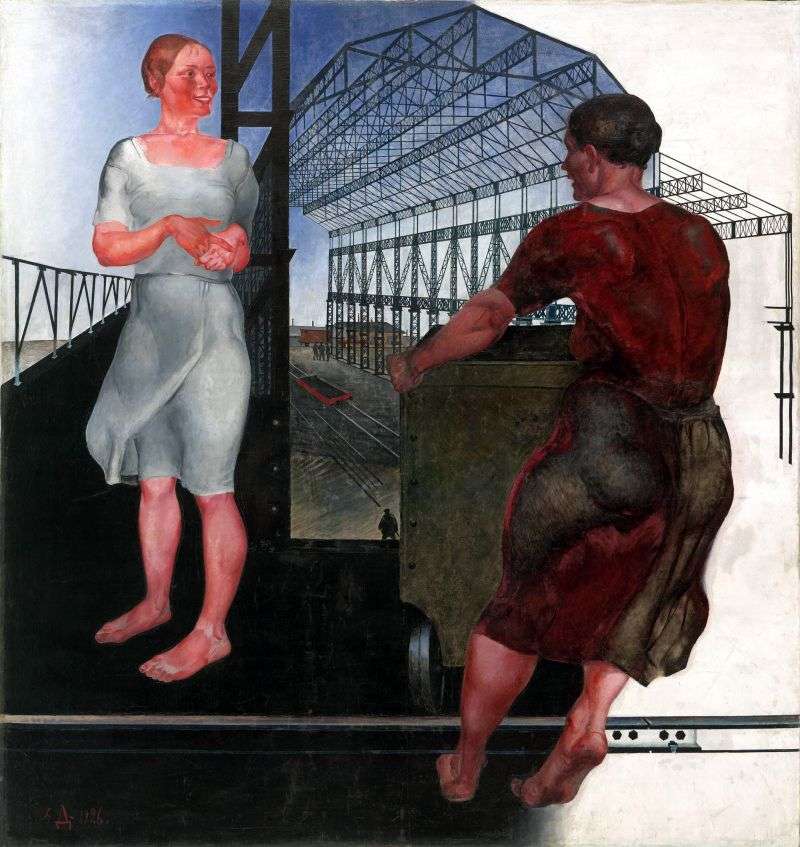 At the construction of new workshops by Alexander Deineka
At the construction of new workshops by Alexander Deineka Moscow-Moscow by Aristarkh Lentulov
Moscow-Moscow by Aristarkh Lentulov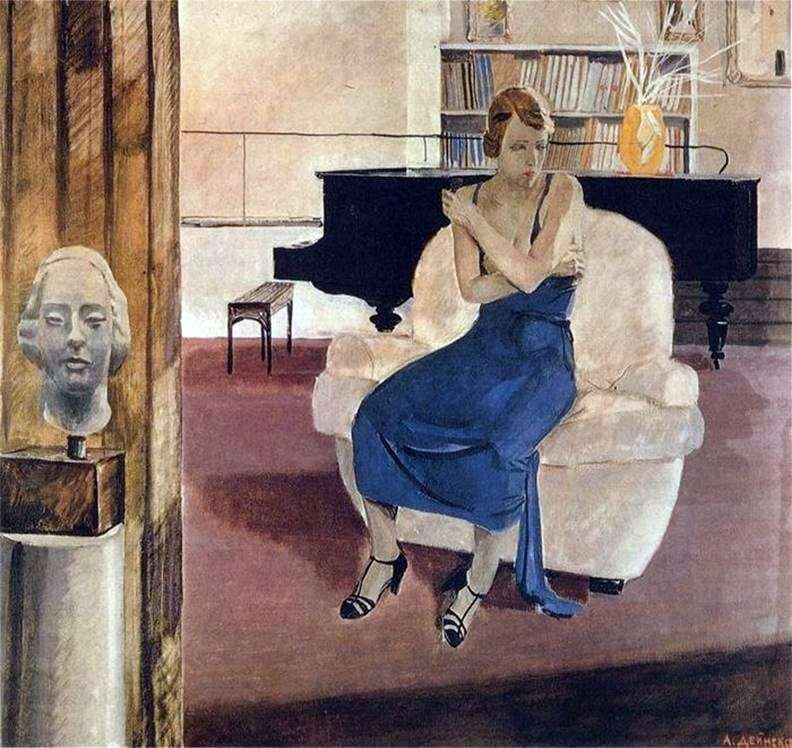 Boredom by Alexander Deineka
Boredom by Alexander Deineka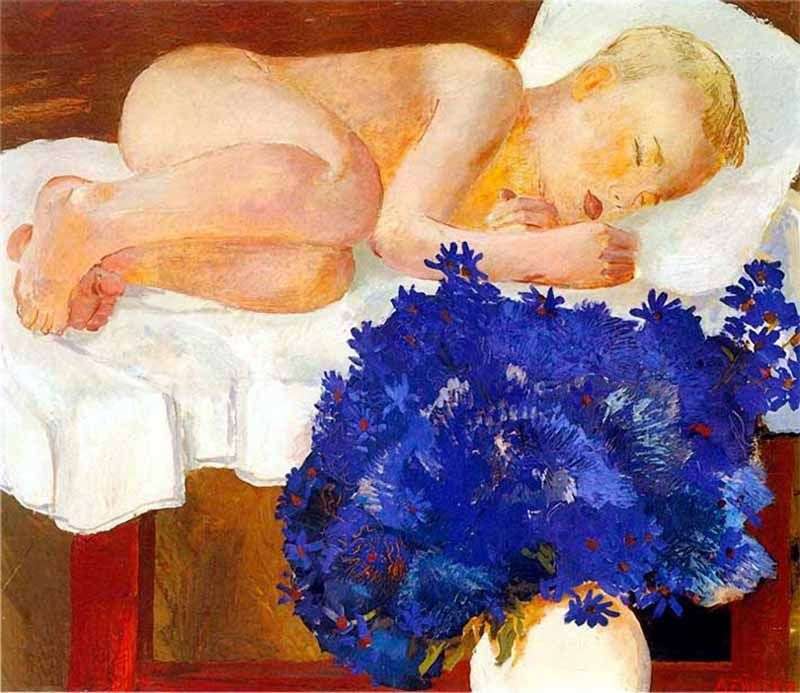 A sleeping child with cornflowers by Alexander Deineka
A sleeping child with cornflowers by Alexander Deineka Moscow II by Vasily Kandinsky
Moscow II by Vasily Kandinsky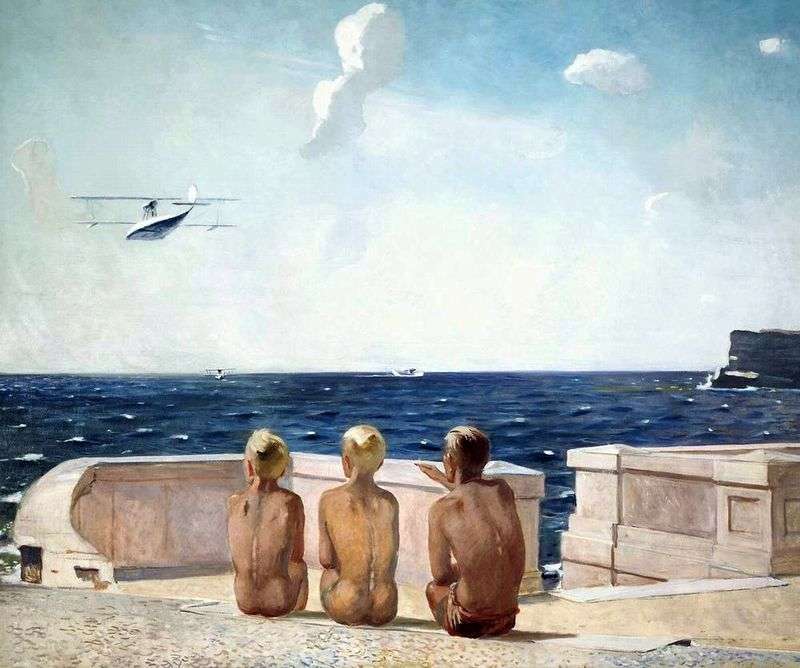 Future pilots by Alexander Deineka
Future pilots by Alexander Deineka Red Square in Moscow by Fyodor Alekseev
Red Square in Moscow by Fyodor Alekseev Winter. The girl at the window by Alexander Deineka
Winter. The girl at the window by Alexander Deineka